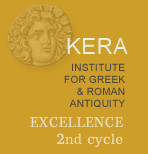Main Site . Sebasteion
6. Honorary inscription for Menestheus
![]()
5 |
Ὁ δῆμος ὁ Βουβ ωνέ[ω]ν ἐτίμησεν Μενεσθέα Τροκόνδου τοῦ Μανέους Ορσισβου, ἄνδρα καλὸν κἀγαθὸν εἰκόνι χαλκῆι καὶ χρυσῶι στεφάνωι, ἐπαίνωι, προεδρίαι ἐν τοῖς ἀγῶσιν, σιτήσει ἐν ταῖς δημοτελέσι θυσία[ι]ς, ἀρετῆς ἔνεκεν καὶ εὐνοίας τῆς εἰς ἑαυτόν. |
The people of Boubon have honored Menestheus, son of Trokondas, son of Manes, alias Orsisbos, a nobleman, with a bronze image and a gold crown, a praise, a presidential seat at the games and free meals at public sacrifices, for his virtue and his goodwill towards them.
Rectangular block, found at the southwest corner of the room. The block was in re-use as the middle block of a 239 x 55 cm x 51 cm pilaster (block A in İnan's reconstruction; İnan 1993, pp. 215; 218; pl. XIII, A; Jones 1979, p. 295). As it was positioned in that pilaster, the honorary text for Menestheus was inverted 90 degrees. The three stones of pilaster A now lie on the ground, and the inscription is not visible.
Height: 68 cm; length: 96 cm; depth: 57 cm; letters: ca. 2 cm.
Jones 1979, pp. 288-289, no. 1 and p. 295; SEG 27 (1977), no. 915; İnan 1993, pp. 215 and 218 (pl. XII.5; XIII; XV; XIV.8; XIX.19); Milner 1998, p. 1, no. 1.1.
L. 2: The personal name Μενεσθεύς is more common in Caria and Ionia than in Lycia. It is attested a couple of times in Pisidia: MAMA 8, no. 349 (cf. no. 353) (Cillanion); Milner 1998, p. 104, no. 2 (A 15-16 and C 17) (from Ormeleis / Tefenni, north of Cibyra). Τροκόνδας is widespread both in Pisidia and in Lycia; Zgusta 1964, nos. 1512-1531. On Μάνης see no. 3.
L. 3: Ορσισβος appears to be unattested. "Other Lycian names begin with 'Ορσ-', and the termination might be connected with the putative Lycian word esvos, 'horse'" (Jones 1979, p. 288).
L. 4-6: the honors given to Menestheus are "customary, especially in the late Hellenistic and early Roman periods" (Jones, loc. cit.).
To judge by İnan's photograph, the speckled greyish and beige stone used for this block is markedly different from those used for the two large pedestals. The letters, with apices, appear to be fairly regular. According to Jones, the inscription must date to the first century BCE or the first century CE.

